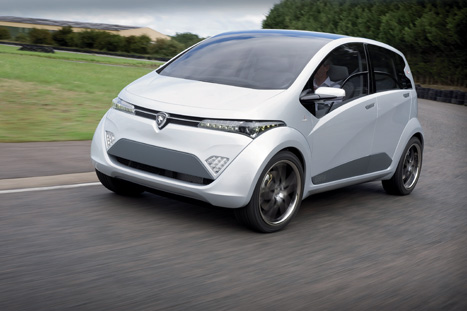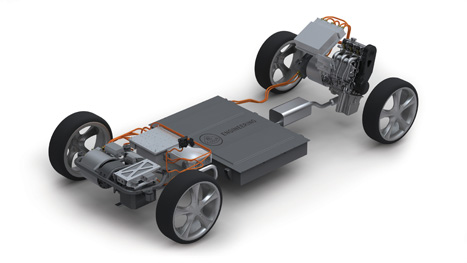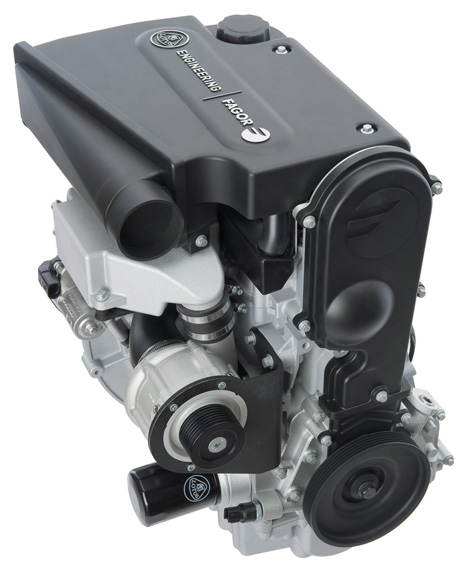Once derided as unappealing, poorly performing milk floats, pure-electric cars have come a long way in a short space of time.
But while vehicles such as the Tesla Roadster, the Mitsubishi i-Miev and the Nissan Leaf have all helped to nibble away at consumer scepticism, the perennial problem of range anxiety the fear that a vehicle simply won’t have enough juice to reach its destination remains a major cause for concern.
One increasingly popular solution to this problem is the range extender, a type of small internal combustion (IC) engine used as a generator to drive a car’s electric motor or to recharge its batteries.

As the engine is not mechanically linked to the drivetrain, its design can be kept fairly simple, which, according to its advocates, makes it particularly attractive to OEMs.
One company leading the development of this so-called series-hybrid technology is Norfolk’s Lotus Engineering, which is working with Spanish engineering group Fagor Ederlan on the development of a system that could enter series production within the next couple of years.
Lotus first developed a range-extender engine for the Limo Green project a luxury hybrid initiative involving Jaguar, MIRA and Caparo. More recently, this three-cylinder, 1.2-litre unit featured on the Proton EMAS, a concept car unveiled by Lotus’s parent company at last year’s Geneva Motorshow. With an electric-only range of 30 miles and a full range of around 350 miles, EMAS was a compelling illustration of the advantages of a range extender, and Lotus is now planning further demonstrations on its own Evora 414E hybrid.
“The big problems with electric vehicles are battery cost and size and range anxiety”
In parallel with these demonstration projects, Lotus has been steadily evolving the design of the system and has now unveiled a production-ready version of the engine that it believes could be applied at relatively low cost, and with minimum fuss, to a range of vehicles.
Available in two versions as either a 35kW unit or a supercharged 50kW unit, the latest version is a three-cylinder, 1.3-litre IC engine able to run on methanol, ethanol and gasoline.
Powering a generator that provides electricity directly to a vehicle’s electric motor, the system is optimised to generate power at engine speeds between 1,500 and 3,500rev/min, allowing a lightweight, simple, two-valve-per-cylinder engine architecture.
Steve Doyle, engineering chief of Lotus’s Hybrid and Electric Vehicle Integration team, believes the system is the perfect solution to the range anxiety conundrum. ’The big problems with electric vehicles [EVs] are battery cost and size and range anxiety; the range extender is the answer to that,’ he said. ’I think it will be a long time before full battery technology will give you the same type of vehicle you have today EVs are the future but, at the moment, the technology ring-fences them into specific applications back to base-type operations for delivery vans, taxis and stuff that goes back to base at the end of the day and has a known range. With this, you’ve got the EV concept for a 30to 35-mile range, which basically means that most of the time you can drive it as an EV but then you’ve got the flexibility if you want to go further.’

According to Doyle, one of the chief attractions of a series hybrid is that it lends itself to a wide variety of makes and models of vehicle. ’We wanted a modular, flexible system,’ he said. ’Parallel hybrid systems tend to be so bespoke to the application and so integrated that actually, if you wanted to put it into a different application, you’ve got to do the whole engineering job again. Typically, OEMs want to be able to use an engine across a range of vehicles, and that’s hard with a parallel hybrid system. They could use the same system on a range of cars and just change aspects [of it and] still carry across much of the architecture.’
Andrew Green, senior project manager at Lotus, has been responsible for ensuring that the new version of the engine addresses as many OEM concerns as possible. ’There are some things in the original design that, when we started talking to OEMs, they said that’s a big no-no,’ he said. ’For instance, Jaguar said “we will not touch nickasil liners” because of warranty issues with low-sulphur fuel. Also, the original was a monoblock. Fagor is used to doing casting and said we don’t want to do that as it’s too risky. We want something that’s simple, low-risk fit and forget.’
Green added that some OEMs were quick to point out that the original 35kW unit simply was not powerful enough. ’When we started talking to premium OEMs, they said that’s not enough. It’s not acceptable for our car to be running in charge-sustaining mode on the autobahns at 50mph. It’s got to run at 80mph, so we’ve stretched the end envelope up to 50kW.’
Although the engine will continue to undergo refinements, the search is now well and truly on for a client and, with much interest from OEMs, Green said the system could enter production as soon as 2012.

Doyle is convinced the range extender is destined to become a critical part of the future automotive energy mix. Despite the fact that the 2011 version of the Nissan Leaf is officially sold out, he’s sceptical of some of the bold predictions being made about the Leaf and other entries to the pure-EV market. ’It looks like a great product, but once you get past the initial uptake, Jo Public is fairly fickle,’ he said. ’Most people have a certain set of requirements a car must meet. One of them might be: I go on holiday once a year and it’s got to get me down to Cornwall from Norfolk. An EV won’t do that for me.’
Green added: ’People still want sports cars and people want estate cars. Some of the bigger OEMs have taken the view that you can buy an EV, but for an on-cost option you can have a range extender. Companies we’re talking to are predicting a 50/50 split between EVs and range-extended EVs.’
in depth range finder - Several car makers are recognising the benefits of range-extender units
Austrian powertrain specialist AVL recently demonstrated a rotary range-extender engine on a prototype Mini, while MAHLE is currently testing and developing a 30kW unit at its Northampton headquarters.
BMW is also reportedly considering fitting its proposed Megacity EV with a range extender.
Meanwhile, the Chevrolet Volt remains the world’s first mass-produced range-extended vehicle.
The Volt combines an all-electric drive unit with a 1.4-litre gasoline-powered engine. Using only the energy stored in its 16kWh lithium-ion battery pack, the Volt has a range of up to 50 miles. In extended-range mode, the engine enables the electric drive unit to provide up to 344 additional miles of range.




Nanogenerator consumes CO2 to generate electricity
Whoopee, they've solved how to keep a light on but not a lot else.